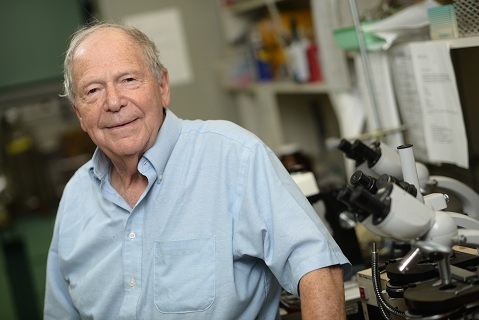Harvard Lyman, Ph.D.
 Professor Emeritus
Professor Emeritus
Department of Biochemistry and Cell Biology
Life Sciences Building
Stony Brook University
Stony Brook, NY 11794-5215
Office telephone: 631-632-8534
E-mail: harvard.lyman@stonybrook.edu
- Research Description
Photoregulation of Chlorplast Synthesis and Replication.
The synthesis and replication of cellular organelles involve an interplay between
nuclear andorganellar genomes. In the case of chloroplasts the interaction may involve
three genomes:nuclear,chloroplastic and mitochondrial. The mechanisms by which these
genomes regulate chlorplast synthesis and replicaton is the subject of our investigations.
Euglena gracilis possesses a chloroplast developmental and division system similar
in several ways to that of higher plants while also having the manipulative advantages
of a microorganism: rapid growth of large populations of uniform cells, rapid mutant
selection and isolation, and ease of biochemical,biophysical and microscopic aanalysis.
Light is required to initiate and maintain the synthesis of the chloroplast from its
precursor, the proplastid. We have identified three different light-absorbing systems
in Euglena which regulate the assembly of the organelle. One of these photomorphogenic
systems acts to form the second messenger, Inositol-3- phosphate which ,in turn,releases
Calcium from internal stores. Calcium, binding to Calcium-binding proteins acts at
a post-translational step in chloroplast assembly. The other two systems apparently
act at transcriptional and enhancing steps.
Light also acts to regulate the synthesis and amount of chloroplast DNA. Evidence
so far suggests that light-activated DNAses serve to regulate synthesis and amount
of plastid DNA. Regulation of Phototaxis Light also controls the swimming of Euglena
toward the light source. (Positive Phototaxis). Euglena possesses an eyespot containing
rhodopdsin- like pigments which are also found in the paraflaggelar body. We have
found using aplastidic and photosynthetic mutants that positive phototaxis requires
a "signal" from a functioning chloroplast. Blocking photsynthetic electron transport
with inhibitors or by mutation does not inhibit light-activated photkinesis(random
swimming), but does block positive phototaxis. The molecular mechanisms underlying
this are under investigation. Photoregulation of Chloroplast Synthesis and Replication.
Regulation of Phototaxis Photoregulated Transmambrane Signalling
|
 Professor Emeritus
Professor Emeritus